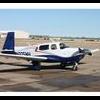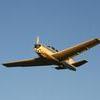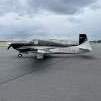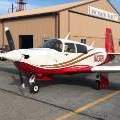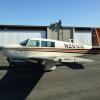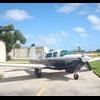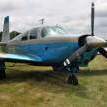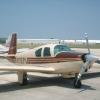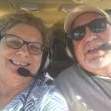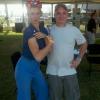Leaderboard
Popular Content
Showing content with the highest reputation on 11/14/2018 in all areas
-
I went to my wife 9 months ago and said I was buying an ovation. I had done the logbook review, talked to the broker, and was going to submit an offer the next day on a ‘97 (I think) ovation 3. I had been talking about upgrading for a while and my wife had always said no. This time she just said not another Mooney. She didn’t find it to be comfortable. I’ll always be a mooniac, but I subscribe to the theory that the best plane for any mission is the one your wife likes. Wife and two little girls (3 and 6 weeks)- I need more space in the plane than would be feasible in an ovation. The goal was family plus bags ~600 miles in 3 hours. Not feasible in an ovation, but not far off in a turbo normalized A36. The Bo won’t make it in 3 hours, but at least it will be a comfortable ride. I brought the plane home and took my wife to see it. I showed her the rear cabin- she sat down and smiled at the space. Then she looked at the panel and said, “no glass? You’re going to redo that right?” So that’s the story of how I bought a Bonanza in May and why the bird is in the avionics shop right now.7 points
-
I just completed a current pilot record for insurance renewal on my Baron. I flew 175 (actually 177.5) hours in the last 12 months, 38 hours in the last 90 days. Of that, 150 was in the Baron and 25 hours in single engine, mostly teaching and exercising a friend's P210. In the last 90 days, 36 of the 38 hours were in the Baron with two flight reviews in single engine, each an hour flight time thrown in. I was expecting about 150 hours last year so 175 hours is a nice surprise. I do have a non-equity partner in the Baron and his time will determine the insurance premium, unfortunately. He has about 25% of the hours I do and flies about 25% as much as I do. But . . . he pays half of the expenses. Oh, and my first flight in the Baron was January 15, 2018 so that 150 hours in the Baron is for a 10 month period, not a full year3 points
-
I really can’t agree that the operating costs of the Bravo are all that high. I say that though with a caveat. That’s once you get it completely dialed in so far as all systems are concerned with everything operating rock solid where you want it. But then again that really applies to any new-used plane that is 15-50 years old. The reliability an dispatch rate of the Bravo has been great, and as mentioned above, it has a Lycoming that will make TBO with little problem if you fly it correctly which really isn’t that hard, and this certainly should be factored into the equation . Some might argue that burning 18 to 19 gallons an hour in cruise is high , but it really is reasonable when you consider the speed and therefore efficiency of the thing, being able to get up and over a lot of weather that you would otherwise have to circumnavigate, etc3 points
-
The 14.9 number works great but is only for LOP ops with a 8.5:1 compression ratio. When ROP HP is more a function of MP and RPM, hence why the "key" numbers work out well. So when rich of peak use "key" numbers (what ever they are for your airplane) and when lean of peak use FF. Cheers, Dan3 points
-
There is plenty written up by MSers that have used desicants and air pumps to supply dry air to their engines for extended periods of time. Lets not confuse the three devices... 1) Heaters are great for warming the engine to avoid really cold starts with really thick oil... 2) Dehumidifiers are For keeping moisture away from corrodable surfaces... 3) Pre oilers are the things that put the oil back on all the surfaces after time and temperature have allowed the oil to drip and drain back to the oil pan... 4) We get some confusion by heating air, where the RH has a tendency to drop. Winter cold air has a pretty low moisture content, and warming it up drives the RH even lower... 5) The problem with this thought process is... the air inside our engines is not following these simple rules... it is high humidity air in a pretty tight container... and some parts are open to the outside through the air intake, others are open to the exhaust, a few parts are open to the case vent If you are not going to fly for a few months... dehumidifiers work, pickling is fine, leaving the engine open is almost good... but leaving part of the engine with moisture still in it at 70°F is likely to increase the rate of oxidation... So why heat the engine up? Mike Busch is really smart, and writes pretty well... rarely has left us uninformed... Tanis is really smart, and writes in a commercially acceptable manner... Taking either of them out of context is a bit dangerous, for your wallet... They may be saying leaving the heat on is harmless.... as in it won’t damage things by overheating or lighting a fire.... But they are not outwardly saying it will do what you want it to do... “heat your engine to prevent internal corrosion...” That is what I would need to see to believe this could work, then I would be looking for an MSer that has done this before... preferably a mechanic that sees multiple engines frequently.... Call the fine folks at Tanis and ask directly their thoughts... They must have had several people each year have the same idea. They aren’t trying to sell something for the wrong reason, just to make a buck... that technique usually has a high failure rate... in this case an expensive failure rate.... If it did work that way, i’d Leave the heat on.... Got Time to make a call? we need a contest... MSer with the most responses from different vendors.... @wcbis pretty good at this! PP thoughts only, my steam tables are printed on paper... Best regards, -a-3 points
-
It's not passenger chatter that get's you (though it might contribute). It's something so distracting that it takes your head completely out of the current task at just the right moment even if only for a fraction of a second and then prevents it from returning to the task completely. I would never say that it could not happen to me or that I could not be distracted. That would be tantamount to a self inflicted curse. I think I'm a decent stick and conscientious about how I do things. I also think that many pilots far superior to me in skill, experience and discipline have screwed this particular pooch...many times. Unsurprisingly, Mr. Deakin has penned some of his wise and entertaining musings on the subject.3 points
-
They are taught in the Mooney Safety Foundation PPP and are called "key" numbers. Goes like this: (RPM/100)+MP = Key number For my J, 44=55%, 47=65%, and 50=75%. Not sure if your F would be the same values or not.3 points
-
2 points
-
2 points
-
Sounds like mine, back n the mid 1980’s I had a warrior to learn to fly in. We went on our first trip the day after I got my PPL, the cars on the highway were just as fast as us or faster, she wanted to know why I got a plane that wasn’t as fast as a car. So we started to look at planes, after looking at a Bo, Cherokee six, C 182 then a Mooney it was over. She sat in them all, I’m not going to trash any other planes,she does, therefore it was a Mooney or nothing. 30years later and now three Mooneys she won’t change her mind a Mooney or nothing.2 points
-
In a normally aspirated Mooney, assuming little/no wind, on a long cross country the goal is to fly as high as it takes to accomplish Carson’s speed at full power! That will be the maximum TAS for the buck you can get. It will end up something like 120kias at 60% power at like 12000ft for a TAS of about 150ktas on 8gph.2 points
-
You want data? I have data. Here is my most recent real time monitoring report. I have done numerous tests at different temps, oil cap open vs closed, etc. I find 90 degrees is a good temp for RH less than 30%. Oil cap open did not make a huge difference in my previous lycoming. I have not tested the oil cap in my current continental. I do leave the cap open because that is where the probe goes. I never saw condensation on the underside of my Lyc oil cap but I have seen it on my Conti cap. Not sure why the difference.2 points
-
2 points
-
Just like LOP power is fuel limited, unless you go WAY ROP, ROP is oxygen limited. The amount of oxygen that is pumped through an engine is determined by volume (RPM) and density (MP), thus ROP power can be figured using a key number. Since SL pressure is about 30", a 1" change in MP equals about a 3.33% change in power. Likewise, since most our engines have a maximum RPM limit of 2700 RPM, a 100 RPM change makes about a 3.7% change in power. While they aren't exact, for initial power settings, those numbers are close enough. Thus the RPM/100 + MP = a key number is pretty close.1 point
-
(Anthony, I'm that last one qualified to be correcting spelling or typos... but 3 times in one line...)1 point
-
1 point
-
1 point
-
Anyone else just use the Mike Busch approach of looking at the fuel totalizer and seeing how much fuel you’ll have when you land and adjusting the red knob to get what you want? I can burn between 10-18 gph at cruise in the Ovation. With “only” the 89 gallon tanks that’s a lot of variability I have when deciding what settings to use. While I like going fast, it’s rarely worth it to burn the extra dinasour juice just to gain a few minutes. Unlike some people here, I haven’t solved any partial differential equations since college and I’d rather fly then mess with an excel spreadsheet so the other methods don’t work well for me. I’d rather play with the real numbers in the air than the theoretical ones on the ground.1 point
-
Well, if it ever happens to you, I promise not to mention this thread (that I've now bookmarked)...1 point
-
You make no sense what so ever. This argument is an argument against purchasing the PF system. It's not like you get your money back if you remove it. So no one would remove a working system just because the improvement was small compared to the cost. The cost is spent at that point. Try again.1 point
-
In the late 90s early 2000s I used to rent various aircraft from Phoenix Aviation (Middle River Aviation) at Martin State north of Baltimore. They had all manner of fixed gear singles on the rental line. There was an O320 powered 172 with one of the earliest PFS exhausts. The Exhaust really woke that airplane up compared to the other Lyc powered 172s. Shorter TO roll and significant climb improvement (~200fpm). Despite being ugly (original 1970s green and orange trim), it was often the first scheduled because of how it performed.1 point
-
I had dinner with a friend and Malibu driver (Piper not Chevy) last week and during the summer he flew into KCGE for crab cakes at Kay's. He remarked that they were the best he's ever had.1 point
-
That's what I would like to do. How did you do it legally? Are you VFR only? Or do you have another display of time including seconds? Our GTN650 will display time, but only hours and minutes unless I dig down deep through the menus. It has a timer that displays seconds, but a timer is not a clock. The AV-20S is only approved secondary. That is, it cannot replace ANY required equipment. For IFR, a clock with a sweep second hand or a digital equivalent is required. If they can get it approved as a primary clock, I'll do the same thing. FAR 91.205.(d).(6) (6) A clock displaying hours, minutes, and seconds with a sweep-second pointer or digital presentation.1 point
-
not many animals on this earth nastyer than a pig --- but man i love me some ribs and bacon..1 point
-
1 point
-
Hi Marauder, You’ll be one of the first to get pictures! AGL Aviation is who I’m partnered with to do installations. Great people!1 point
-
Noted on jinxing. Also on the get gear down to slow down. I have lots of energy to get rid of since I am usually at the top or above the white arc at the threshold. the ones I hate are, when driving away from the airport, I wonder if I did all 4 checks of the gear. I mean clearly I did because the plane rolled back into the hangar just fine, it would not do that if the gear was up,, right?1 point
-
Thanks for the compliment - but as you identified I am not Czech (Irish in fact), I will be following up with more pictures on the trip - got some today of the parts after they came out of the nickel plating - I imagine there is a website somewhere on the internet for engine porn - but I really am enjoying this process. Looking forward to getting some new cylinders – and more peace of mind, I think on buying a plane with an engine that is not new or nearly new there is always doubt which weighs on you when you are flying, now that everything will be ship shape and new I can enjoy flying even more.1 point
-
There were a lot of smaller things they did to save money on the Eagle, some of which can be upgraded - the lighter prop allowed them to remove 16 lbs in ballast weights from the back of the airplane, the de-rated IO-550 engine, the insulation as you mention, the vast majority had cloth seats, the control yokes were painted instead of leather covered, the paint scheme was much less labor intensive. But the number one thing that they saved a huge amount on was the autopilot which has been, up until this point, too expensive to retrofit. They only put basic Stec 30 autopilots in the Eagles which would not fly a coupled approach. The Ovations had either the KFC150 (in 1999) or the KFC225 autopilot (in 2000 -2004), either of which was a complete flight control system capable of fully coupled approaches, vertical speed, altitude pre-select, etc. This meant an Attitude Indicator on the Eagle instead of a Flight Director and a less expensive Stec ST-180 HSI instead of the King KCS-55A HSI and remote gyro compass system. - - - I agree completely on the Bravo vs. Acclaim. The oil cooled valve guides on the Bravo engine allow the vast majority to make it to TBO without a top end overhaul. At top speed there is about 10-15 knots difference, but for the cost difference I think the Bravo is one of the best buys on the used airplane market considering its top speed. The number one reason I have never owned an Acclaim is that someday down the road when Garmin decides to stop supporting parts or databases for the G1000, it will not be a good day for the G1000 Mooneys*. Someone will probably come up with an ingenious way to retrofit other avionics, but it's going to be tough since the G1000 is part of the Type Certificate. With the things going on in avionics right now I would hate to be tied to one option. * As an example, Garmin announced that, 15 years after the last one was produced in 2004, they will stop repairing the GNS480 (or Apollo CNX480) starting next summer. They also announced that next summer they will stop providing databases to the GX50, meaning you won't be able to keep the database IFR current.,1 point
-
Heating or cooling the engine will not introduce moisture. It is just there. A warmer temperature will hold more of that water as vapor and therefore not available to cause corrosion. Immediately after a flight I see RH climb as the engine cools. It peaks around 12 hours post flight and then gradually reduces over the next 2 days. I have seen 100 % RH after taxiing only when I didn’t turn on the heater. I turned the heat on and after a day it dropped to 30%. Taxiing without flying is definitely a bad thing.1 point
-
You can always do flight testing for your airplane. Develop your own power settings and speeds. Determine your own best glide speed. Set the power at idle and maintain different speeds. Write down the sink rate for every speed you try. Minimum sink rate will give you max endurance speed but best glide will be a bit higher. Use the sink rate, TAS, and trigonometry to determine which speed gives you the shallowest descent angle. And remember, best glide speed, just like stall speed will vary with weight.1 point
-
1 point
-
What are you willing to pay? March is nice, I’ll put my plane outside and you can use my hangar.1 point
-
I think the DX (2004) was the last year of the Mac 2 blade. The top prop was used on all later models iirc. The Ovation 2 was 280 and the Ovation 3 had the stc 310. Most of the 2000-2004 2 blade units have been swapped out. They were really fast and efficient but you had to get out and push the plane down the runway1 point
-
First off the eagle wasnt really stripped of options. It had a 2 blade, which can be switched back to a 3 blade. The part that made a difference in weight was the insulation for sound proofing. The eagle is louder to fly, but its not noticeable when youre wearing an ANR headset. The one i have still has a GPS, speed brakes, leather interior. Other than that, there's not a whole lot of differences. And operation costs delta between the acclaim and the bravo arent that big. Every acclaim ive seen needed a top overhaul half way. The bravo uses a tad but more fuel but saying in the end the difference in ownership is negligible between a 400k acclaim and a 150k bravo plus another 100k in upgrades is a bit off. Just my opinion however. I might be completely wrong.1 point
-
As one who is also following the a36 market closely it amazes me how much more the bonanza brings in the used market. A nice (‘82) sold awhile back for around the same price as a 2000 ish Ovation. The newer ones really suffer with UL but they are kind on the eyes. I’d take an eagle for the right price. However, the 95-98 Ovation or DX is my desirable range...I like the 9 pack.1 point
-
I'd also have to agree that the 1994 to 2004 ovations and eagles are an awesome buy. Personally my favorites are the 99 to 04's because they organized the panel a tad bit better in my opinion but that's all personal preference. Most of the regular O1's seem to be going for around 140 to 180k. The cheapest ovation GX with waas I found was 295K. I Think its a way better investment to take an eagle or an Older Ovation, or bravo, and just upgrade the panel, interior, and paint to what you want. 115 to 155k saved leaves a lot of room for options. With that you can do a full panel upgrade and not be completely locked into garmins G1000 program. Older planes also tend to have a better useful load. especially the eagle. With 1135 Lbs of useful load I can take throw 4 people and still take 75 gallons.1 point
-
The Citation X I fly now has a pressurized baggage compartment. I’d flow CJs for 23 years and no problems with water in nose and sodas. I always kept crew bags in nose and pax bags in tail baggage compartment. Sent from my iPhone using Tapatalk1 point
-
I like your argument, but lets assume then there is NO flying going to happen. I.e., out of the country for three months. I will pickle the engine as per Continental's instructions (pickle oil, dessicant spark plugs, dessicant bags in exhaust and sealing it etc). Given that I really respect Mike Busch and his way of thinking, I haven't heard too strong an argument for NOT leaving the Tanis on, hence my approach right now is to pickle and leave the Tanis on Dec - Feb as the best thing to do for the engine. You can do up to 10 hours on the pickle oil, so if a chance presents itself, I'll go do a run around the patch for an hour whenever I can.1 point
-
Hah! during my instrument training, on a particularly grueling approach to a towered airport, I did the missed approach, but I had to push forwards to keep the nose down, no matter how long I held down the trim button. I started getting frantic and told my instructor, "hey, something's wrong, I think my trim switch is stuck!" There was a brief pause, and he said "that's because you're actually holding down the mic button instead." Fortunately the tower didn't hear that part...1 point
-
Well first and foremost, welcome to the Mooney Club and congrats. A friend of mine and I just bought a Mooney a little over a week ago. The first plane we looked at, Don did the pre-buy and did a terrific job! I also want to give kudos to Dave at Air Mods, which is where we bought our Mooney from, and also Brian at Orion Flight in Quakertown, PA. Dave stated that Brian did a very thorough pre-buy, and I conclude. Don, Dave and Brian are all Mooney experts in my book!1 point
-
I am obviously in the market for a new AP. (going on 3 or 4 years now with no AP) These three are sooooo similar I am simply trying to highlight how close they are and light a fire under them (maybe they will get on the F and G quicker now). In fairness as I said I am glad to have had even a response. If you may remember I have posted communication between Trutrak and Trio as well. I even pointed out to Trutrak and Trio the demographic market is bigger for Mooney than the Grumman and some of the other aircraft models. (On a side note it does not take rocket since to look at some of these demographics and yet sometimes Mooney Models get put behind other models). Also, as a collective group the more we ask for things the sooner we will get them and I have nothing but very good things to say about working with and contacting all of these vendors (Garmin, Trutrak, Trio, Avidyne or JPI)1 point
-
1 point
-
1 point
-
I can’t believe I liked this post! I probably need to build a bigger, heated, dog house...1 point
-
My fuel servo has slowed mine down considerably over the past 3 weeks.... Top speed has been 10-15 ktas, behind a tug, back and forth from the mechanics hangar and mine.1 point
-
I have a 211 conversion , All you have to do is make little radius pieces out of aluminum for about a buck a piece , and WHAM.... New style windows...1 point
-
1 point
-
If that is a set of valves, one intake and one exhaust... 1) Intake: That may be the backfire promoter valve? 2) Exhaust: That may be the power reducing flame thrower valve? This is my attempt of using some limited knowledge and combining it with some limited sense of humor. it would probably take a really good muffler to restore engine power to an engine outfitted with those valves. Where did they come from? Best regards, -a-1 point
-
Well, if looks are what polishes your plow... but it is my understanding that the C172 performance benefits tremendously from the PFS.1 point

